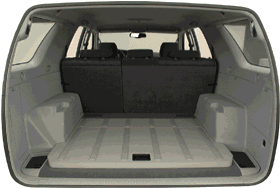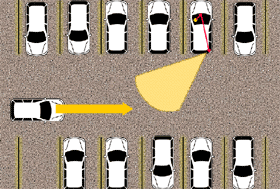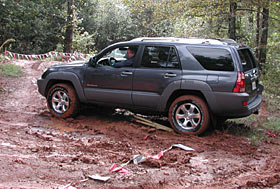|
|
||||||
|
Stepping inside the new 4Runner you immediately notice a huge difference from the previous model. Owners of the '03 trucks will be the envy of all other previous 4Runner owners - especially those with the new Limited models. What immediately caught our eye when we sat in the new truck was the gauge cluster, which looks awfully similar to the new Nissan Xterras. But you know what they say - imitation is the best form of flattery.
The new interior is, in fact, much more spacious and plush than previous models. The seats are better-padded than before and have plenty of adjustment to get you comfy for those long rides on the highway or in the back country. Also keeping you comfortable is standard automatic climate control on all models. Though the system is indeed nice, the controls were not very intuitive and were not immediately usable without a bit of quick studying. Of course, once we figured it out, they were simple enough to get used to. A multi-display also shows time, ambient temperature, fuel range meter, average speed, and average fuel consumption. If you're really into high-tech, a DVD-based GPS navigation system is also available on all three models. Everyone knows for those long trips you'll need good tunes. Though XM Radio is all the rage lately, it is not yet offered on the 4Runner. What is offered, however, is an AM/FM/Cassette/CD setup with six speakers and wheel-mounted controls. If you really want your tunes to crank, go for the 360 watt JBL Synthesis system which offers surround sound, ten speakers and rear seat audio (RSA) with remote wireless headphone capability. RSA will be great for when the kiddos want to listen to Creed in the back seat and you'd much rather listen to Kenny G up front. OK, well hopefully not Kenny G, but you get the point. Keeping front passengers safe in a collision are dual front air bags. Front seat-mounted side impact and overhead front and rear side curtains are also available. One of the coolest features of the new 4Runner for us is what is actually referred to as "the burger tray" in the back seat. Just as you'd expect, the burger tray is perfect for storing your food during those trips to the local fast food joint. Up front, you'll still have to use the usual cubby holes, but they are still pretty usable. Another innovative feature is the new "double-decker" rear storage shelf. The shelf lays flat in normal situations in the rear cargo area. When you have too much stuff to put in the back, the shelf is easily raised with one hand and provides a second tier of storage, capable of holding up to 66 pounds. But the best new feature of all is the new parking assist mirror setup. Here's how it works. On each rear pillar a mirror is mounted at an angle. Now imagine yourself in a crowded parking lot. You're trying to back out but you are flanked by two vans and you can't see if anyone is coming. No problem! By looking in the rear-view mirror, you can focus on either rear mirror and essentially look around the corner to see if anyone is coming. It takes a bit of getting used to but once you figure it out it's hard to imagine not using it. Note, though, that the mirrors are not available if you order the JBL sound system, as the mirrors are replaced with speakers.
Alright, so there's the quick run-down. The 4Runner has so many other nifty technological advances that it would take many more pages than this to describe them all. We've tried to touch on some of the main points since this is basically a brand new vehicle. We'll have to wait until later for a full-week test drive but for the 4Runner's introduction, we visited the gang from Toyota at the famous Road Atlanta race track, which is home to the Panoz race team and racing school and also served as home-base for the drives. We didn't get to go on the actual track because there were cars taking hot laps. But what the track did do was spend time prior to our visit with Toyota developing two off-road test courses - one for 2WD vehicles and one for the 4WD models. Atlanta hadn't seen much rain all year and the night before we arrived, over four inches fell, turning the course into Georgia clay mud. Road Atlanta would not allow us out on the 4WD course, but the "2WD" course proved to be test enough for the new 4Runners. By chance, we hopped into what turned out to be the only 4WD truck in the fleet. This was appropriate, though, considering that we were the only off-road publication at the event. The course began with a quarter mile grass and dirt 2 track trail alongside the road. The trail was very bumpy and very rutted out. We were in the lead and were charging quite fast down the path. We discovered quickly that the VSC system was a bit over-active, as it would thwart our every attempt at spinning out and having some fun in the mud. You could hear and feel the brakes varying and grabbing at each over-spin of a wheel. Luckily, this is one system that is actually defeatable with a switch. But we mostly left it on in order to see what it was really all about. We suspect that in most real-world scenarios the system would work well - just not for those of us wanting to have fun off-road. Immediately noticeable on the bumpy trail was how smooth the suspension was. Our tester was without a doubt the smoothest vehicle we have ever taken over such terrain and was, in fact, far superior. It soaked up the bumps and ruts wonderfully as we bound across the trail. Once we reached the end of the 2-track, we headed into the windy, wooded trail that was intended to show off the 4Runner's suspension and Downhill Assist Control. Two things the die-hard off-road crowd won't like is that the 4Runner no longer has a manual transfer case shifter. A dash-mounted switch now handles the shifting duties. Also gone is a hand brake, which is now a push-on, push-off foot pedal. Though you won't be able to use the hand brake in sticky situations anymore, the move does free up a ton of space in the center console. Shifting into 4Lo, we entered the trail. Getting used to the DAC took faith. Having learned how to properly brake a vehicle downhill made me want to feather the brake pedal. Forcing myself to keep my feet off the pedals was tricky but did prove that the system works - mostly. We still felt like the descent was a bit fast for our liking, but it should work great for most people in most situations. Lucky for us, DAC defaults to the off position and must be switched on manually.
Out of curiosity, the first thing we tried was giving it some gas just to see what it felt like. The VSC thwarted our every effort to toss some rooster tails, keeping the speedometer at a rather lame 20mph or so. Obviously, we weren't going to get anywhere soon. Not happy that the VSC thought it was smarter than me, I hit the VSC switch and turned the system off, allowing me free reign of the accelerator pedal. Now we're talking! Some two-footed pedal action got things going. Some wheel sawing, some heavy gas here and some brake pedal stomping there got the 4Runner back on-track in no time, to the amazement of everyone present - including the folks from Toyota. If this wasn't enough, we also got to attempt to free another truck up the next hill. The driver had slid off-course into the brush. He was off-camber and completely stuck. Bailing out the passenger side door, he turned the truck over to me. By that time, he had rutted out the trail quite well. I tried every trick in my book but could not free the 4Runner. I must have burned of 4,000 miles worth of tread on those rear tires. In fact, I never saw so much smoke coming from mud! Alas, we had found the muddy limits of the 2WD 4Runner. Had we been in the 4WD model I am quite confident that we could have freed it from its bushy grave - in fact, it probably never would have ended up there in the first place. The nice thing about this particular stuck, though, was that it wasn't my truck - so I left it and hiked back to base-camp. Once back at camp, we grabbed a V8 Limited and hit the country roads that surround the area. Throttle response was quick, the transmission smooth, and the suspension tight. The 4Runner's suspension and X-REAS system soaked up the curves and provided plenty of fun in the twisties. The 4Runner can definitely get out of its own way! We'll have to wait for a longer-term drive to further form an opinion on the new 4Runner. Our initial response is that we're very excited about the new version. It looks great, it's much roomier, and the 4WD model did great in the mud - despite street tires. As for how it will do on the rocks, it's hard to say for sure at this point. It has wonderful ground clearance but it is approach and departure angle challenged. The lack of an optional limited slip or locker is a drag for the real off-road crowd, but out of the box, the Torsen and electronic brake systems do a wonderful job of controlling tire spin. We can't wait to try it out on our home turf on some real rocks to see how it does. Can it out-wheel a Wrangler off-road? Of course not. But buyers of the 4Runner are not likely to be cross-shopping a Wrangler anyway. Think more along the lines of Liberty or Grand Cherokee in the Jeep line. Toyota plans to ramp up to 12,000 vehicles a month by the end of 2002 and they expect 65% of those to be V6 models and 45% 2WD. 4Runners come with a 36-month/36,000 mile basic warranty and an additional 60-month/60,000 mile warranty covering powertrain components. Learn more about the 2003 4Runner at www.toyota.com |
||||||





